air conditioning Alfa Romeo 8C 2007 Owner handbook (in English)
[x] Cancel search | Manufacturer: ALFA ROMEO, Model Year: 2007, Model line: 8C, Model: Alfa Romeo 8C 2007Pages: 223, PDF Size: 14.35 MB
Page 6 of 223
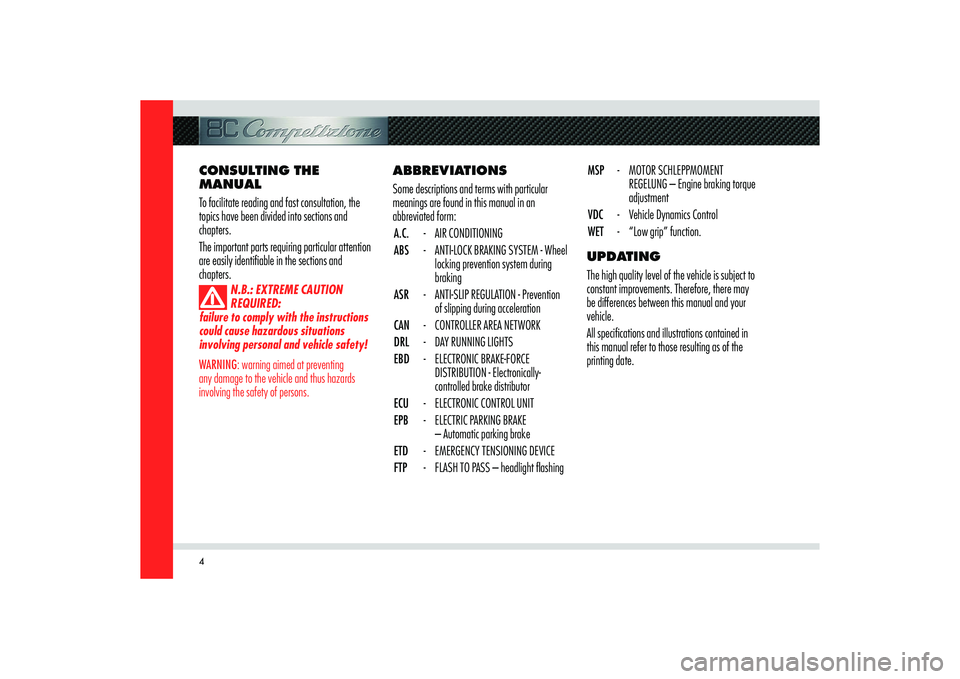
4
ABBREVIATIONS
Some descriptions and terms with particular
meanings are found in this manual in an
abbreviated form:
A.C. - AIR CONDITIONING
ABS - ANTI-LOCK BRAKING SYSTEM - Wheel
locking prevention system during
braking
ASR - ANTI-SLIP REGULATION - Prevention
of slipping during acceleration
CAN - CONTROLLER AREA NETWORK
DRL - DAY RUNNING LIGHTS
EBD - ELECTRONIC BRAKE-FORCE
DISTRIBUTION - Electronically-
controlled brake distributor
ECU - ELECTRONIC CONTROL UNIT
EPB - ELECTRIC PARKING BRAKE
– Automatic parking brake
ETD - EMERGENCY TENSIONING DEVICE
FTP - FLASH TO PASS – headlight fl ashingMSP - MOTOR SCHLEPPMOMENT
REGELUNG – Engine braking torque
adjustment
VDC - Vehicle Dynamics Control
WET - “Low grip” function.
UPDATING
The high quality level of the vehicle is subject to
constant improvements. Therefore, there may
be differences between this manual and your
vehicle.
All specifi cations and illustrations contained in
this manual refer to those resulting as of the
printing date. CONSULTING THE
MANUAL
To facilitate reading and fast consultation, the
topics have been divided into sections and
chapters.
The important parts requiring particular attention
are easily identifi able in the sections and
chapters.
N.B.: EXTREME CAUTION
REQUIRED:
failure to comply with the instructions
could cause hazardous situations
involving personal and vehicle safety!
WARNING: warning aimed at preventing
any damage to the vehicle and thus hazards
involving the safety of persons.
Page 8 of 223

6SYMBOLSSome components of your ALFA ROMEO, are
equipped with coloured labels, applied onto
or next to them. The symbols shown on these
labels are important warnings that the user must
follow when using the component involved.
Below is a summary of all the symbols used
on the labelling of your ALFA ROMEO. The
component to which the symbol draws your
attention is shown next to the symbol.
In addition, the meaning of the symbol shown
is also indicated according to the following
sub-division: danger, prohibition, warning,
mandatory - with respect to that same symbol.DANGER SYMBOLS
Battery
Corrosive liquid.
Battery
Explosion.
Fan
It can start up automatically even with
the engine off.
Expansion tank
Do not remove the cap when the
coolant is hot.
Coil
High voltage.
Belts and pulleys
Moving elements; Keep body parts and
clothing away.
Air-conditioning lines
Do not open. Gas under high pressure.SYMBOLS OF
PROHIBITIONS
Battery
Do not approach with open fl ames.
Battery
Keep children at a safe distance.
Heat guards - belts - pulleys - fans
Do not touch with your hands.
Engine compartment ECU protection
cover
Do not direct the jet of water on the
ECUs, relays and fuses.
Page 45 of 223
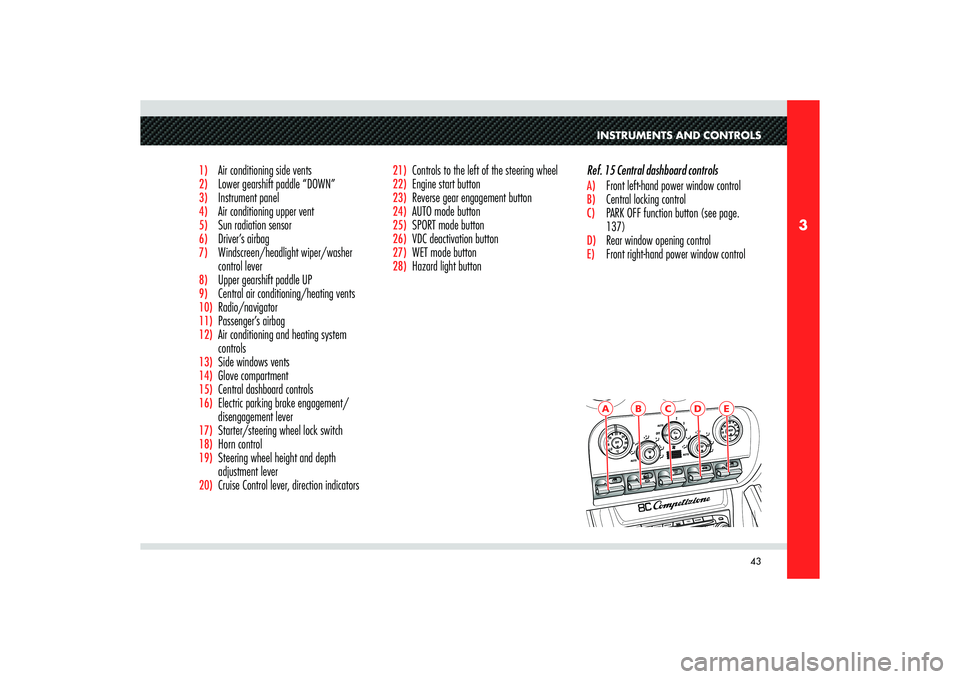
43
3
A
B
C
D
E
INSTRUMENTS AND CONTROLS
1) Air conditioning side vents2) Lower gearshift paddle “DOWN”3) Instrument panel4) Air conditioning upper vent5)
Sun radiation sensor
6)
Driver’s airbag
7)
Windscreen/headlight wiper/washer
control lever
8)
Upper gearshift paddle UP
9)
Central air conditioning/heating vents
10)
Radio/navigator
11)
Passenger’s airbag
12)
Air conditioning and heating system
controls
13)
Side windows vents
14)
Glove compartment
15)
Central dashboard controls
16)
Electric parking brake engagement/
disengagement lever
17)
Starter/steering wheel lock switch
18)
Horn control
19)
Steering wheel height and depth
adjustment lever
20)
Cruise Control lever, direction indicators
21)
Controls to the left of the steering wheel
22)
Engine start button
23)
Reverse gear engagement button
24)
AUTO mode button
25)
SPORT mode button
26)
VDC deactivation button
27)
WET mode button
28)
Hazard light buttonRef. 15 Central dashboard controls
A) Front left-hand power window controlB) Central locking control C) PARK OFF function button (see page.
137)D) Rear window opening control E) Front right-hand power window control
Page 79 of 223
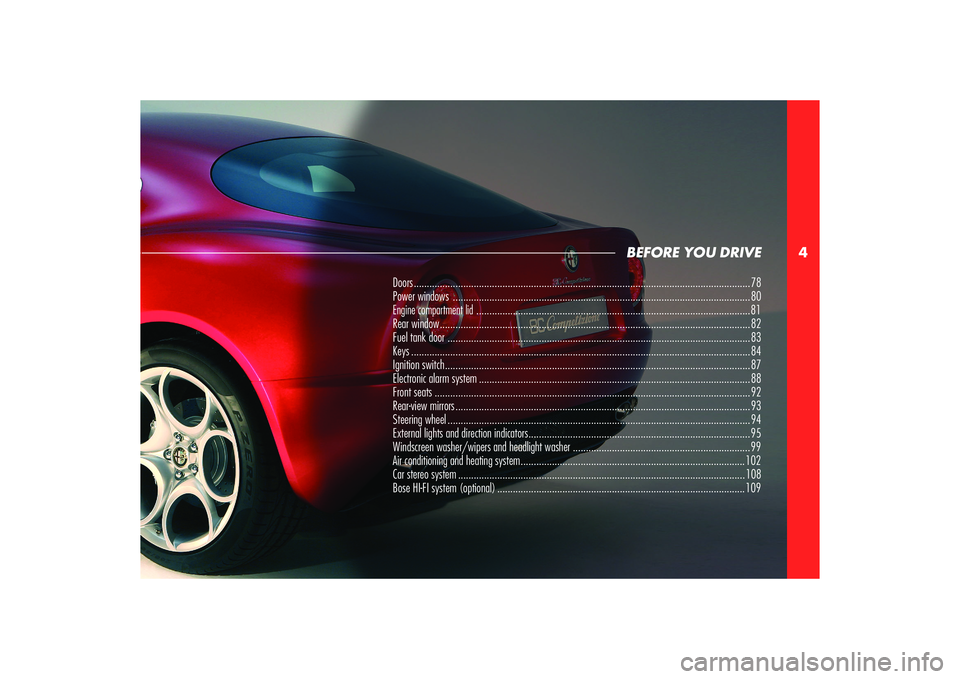
4
BEFORE YOU DRIVE
Doors ................................................................................................................................. 78
Power windows .................................................................................................................. 80Engine compartment lid
......................................................................................................... 81
Rear window ....................................................................................................................... 82
Fuel tank door .................................................................................................................... 83
Keys .................................................................................................................................. 84
Ignition switch ..................................................................................................................... 87
Electronic alarm system ........................................................................................................88
Front seats ......................................................................................................................... 92
Rear-view mirrors ................................................................................................................. 93
Steering wheel .................................................................................................................... 94
External lights and direction indicators ..................................................................................... 95
Windscreen washer/wipers and headlight washer .................................................................... 99
Air conditioning and heating system ...................................................................................... 102
Car stereo system .............................................................................................................. 108
Bose HI-FI system (optional) ............................................................................................... 109
Page 104 of 223
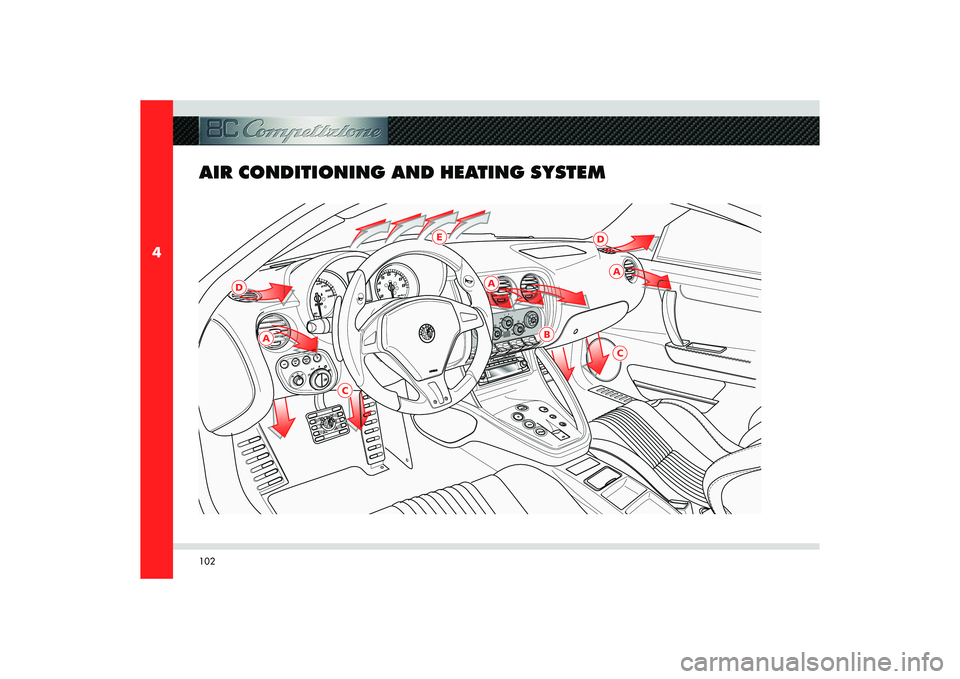
102
4
D
A
C
B
C
A
D
E
A
AIR CONDITIONING AND HEATING SYSTEM
Page 105 of 223
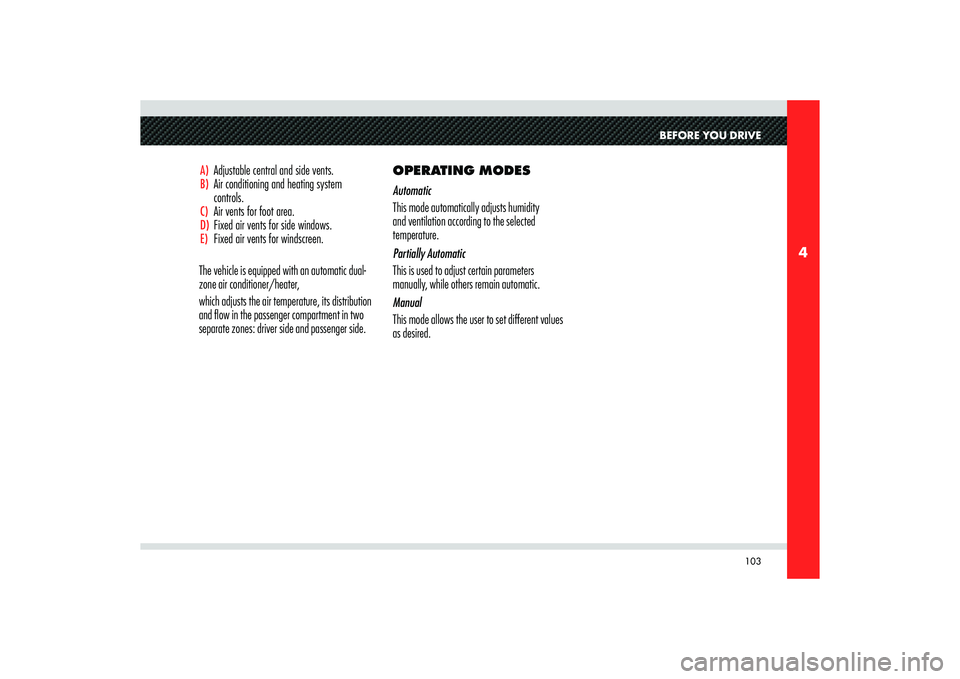
103
4
BEFORE YOU DRIVE
A) Adjustable central and side vents.B) Air conditioning and heating system
controls.C) Air vents for foot area.D) Fixed air vents for side windows.E) Fixed air vents for windscreen.
The vehicle is equipped with an automatic dual-
zone air conditioner/heater,
which adjusts the air temperature, its distribution
and flow in the passenger compartment in two
separate zones: driver side and passenger side.OPERATING MODES
Automatic
This mode automatically adjusts humidity
and ventilation according to the selected
temperature.
Partially Automatic
This is used to adjust certain parameters
manually, while others remain automatic.
Manual
This mode allows the user to set different values
as desired.
Page 106 of 223
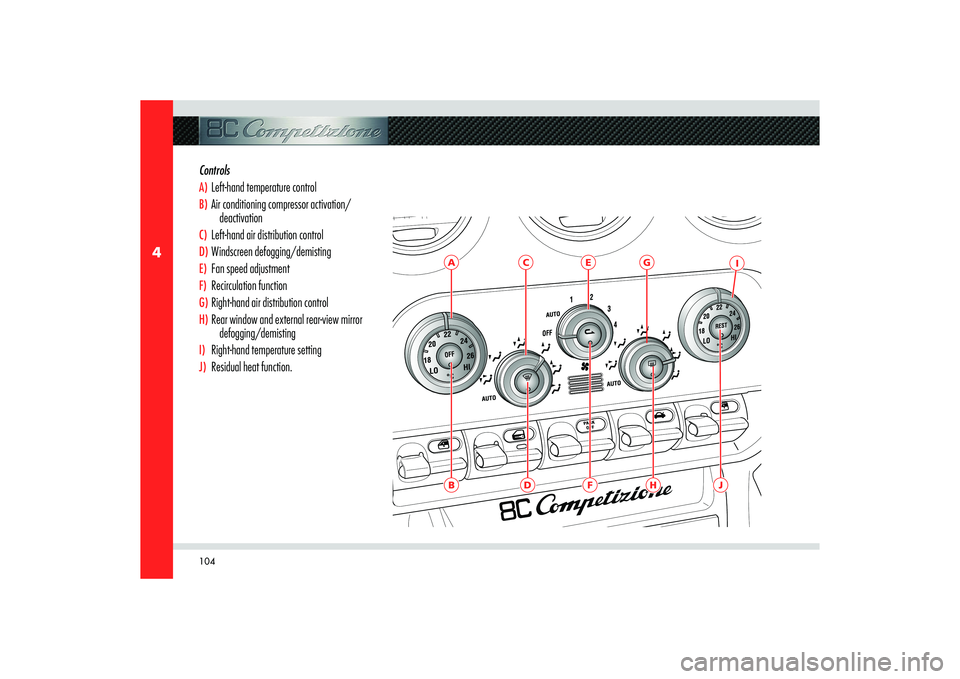
104
4
AB
D
F
H
J
C
E
G
I
Controls A) Left-hand temperature controlB) Air conditioning compressor activation/
deactivationC) Left-hand air distribution controlD) Windscreen defogging/demistingE) Fan speed adjustmentF) Recirculation functionG) Right-hand air distribution controlH)
Rear window and external rear-view mirror
defogging/demisting
I) Right-hand temperature settingJ) Residual heat function.
Page 107 of 223
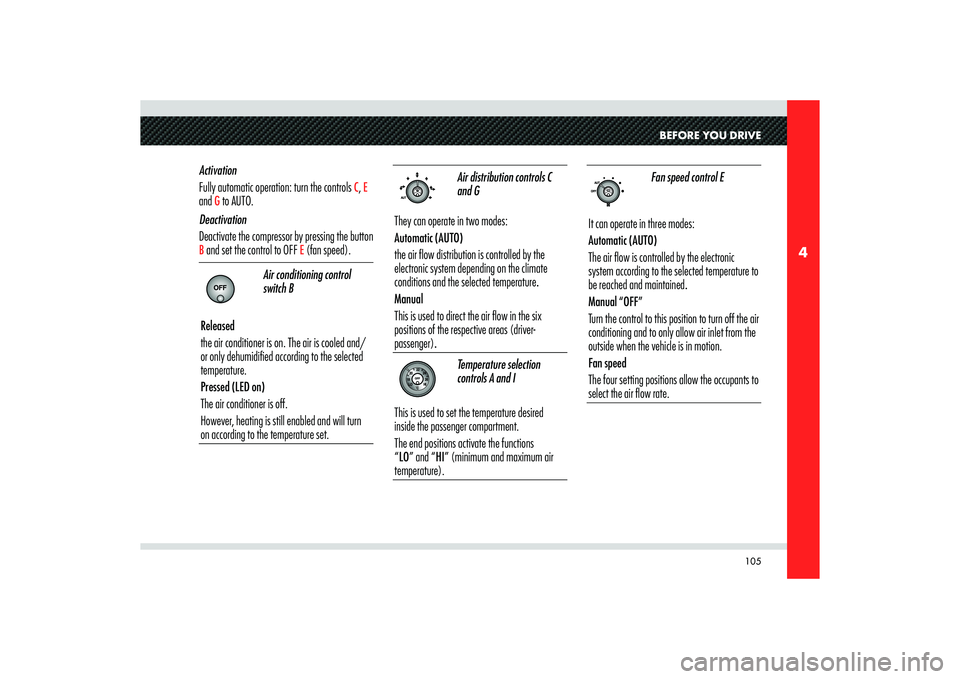
105
4
BEFORE YOU DRIVE
Air distribution controls C
and G
They can operate in two modes:
Automatic (AUTO)
the air flow distribution is controlled by the
electronic system depending on the climate
conditions and the selected temperature.
Manual
This is used to direct the air flow in the six
positions of the respective areas (driver-
passenger).
Temperature selection
controls A and I
This is used to set the temperature desired
inside the passenger compartment.
The end positions activate the functions
“LO” and “HI” (minimum and maximum air
temperature). Activation
Fully automatic operation: turn the controls
C, E
and
G to AUTO.
Deactivation
Deactivate the compressor by pressing the button
B and set the control to OFF
E (fan speed).
Air conditioning control
switch B
Released
the air conditioner is on. The air is cooled and/
or only dehumidified according to the selected
temperature.
Pressed (LED on)
The air conditioner is off.
However, heating is still enabled and will turn
on according to the temperature set.
Fan speed control E
It can operate in three modes:
Automatic (AUTO)
The air flow is controlled by the electronic
system according to the selected temperature to
be reached and maintained.
Manual “OFF”
Turn the control to this position to turn off the air
conditioning and to only allow air inlet from the
outside when the vehicle is in motion.
Fan speed
The four setting positions allow the occupants to
select the air flow rate.
Page 116 of 223
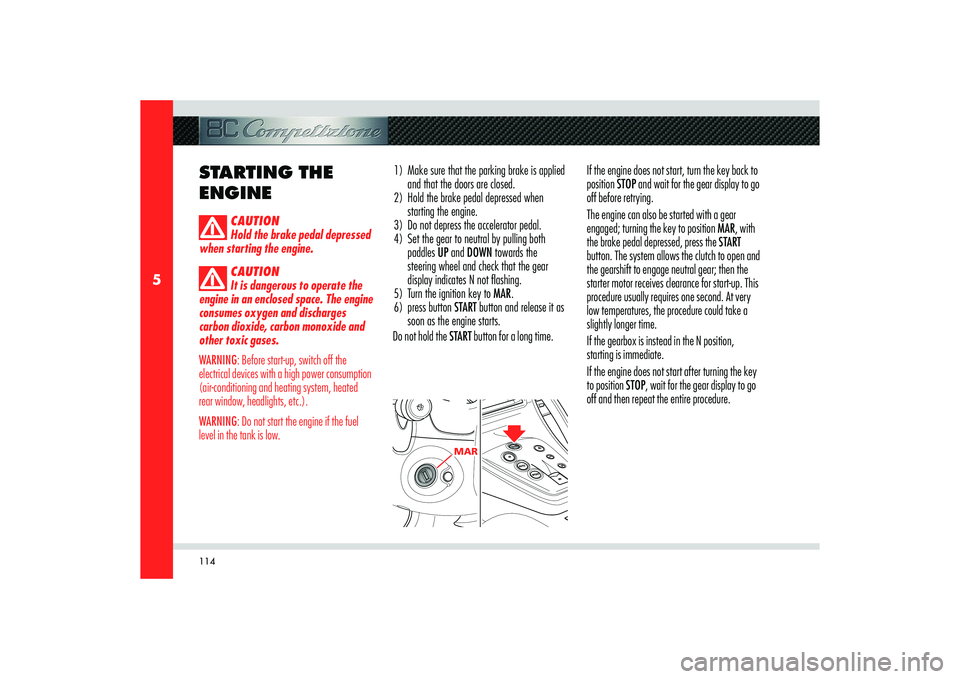
114
5
MAR
STARTING THE
ENGINE
CAUTION
Hold the brake pedal depressed
when starting the engine.
CAUTION
It is dangerous to operate the
engine in an enclosed space. The engine
consumes oxygen and discharges
carbon dioxide, carbon monoxide and
other toxic gases.
WARNING: Before start-up, switch off the
electrical devices with a high power consumption
(air-conditioning and heating system, heated
rear window, headlights, etc.).
WARNING: Do not start the engine if the fuel
level in the tank is low.
1) Make sure that the parking brake is applied
and that the doors are closed.
2) Hold the brake pedal depressed when
starting the engine.
3) Do not depress the accelerator pedal.
4) Set the gear to neutral by pulling both
paddles UP and DOWN towards the
steering wheel and check that the gear
display indicates N not fl ashing.
5) Turn the ignition key to MAR.
6) press button START button and release it as
soon as the engine starts.
Do not hold the START button for a long time.If the engine does not start, turn the key back to
position STOP and wait for the gear display to go
off before retrying.
The engine can also be started with a gear
engaged; turning the key to position MAR, with
the brake pedal depressed, press the START
button. The system allows the clutch to open and
the gearshift to engage neutral gear; then the
starter motor receives clearance for start-up. This
procedure usually requires one second. At very
low temperatures, the procedure could take a
slightly longer time.
If the gearbox is instead in the N position,
starting is immediate.
If the engine does not start after turning the key
to position STOP, wait for the gear display to go
off and then repeat the entire procedure.
Page 135 of 223

133
5
USING THE VEHICLE
- Use the high beams only outside of urban
areas and when you are sure that they will
not disturb other drivers.
- When another vehicle is approaching,
switch the high beams (if on) to low
beams.
- Keep the lights and headlights clean.
- Outside urban areas, beware of animals
crossing the road. DRIVING IN THE RAIN
Rain and wet roads are dangerous. On a wet
road all the manoeuvres are more difficult since
wheel grip on the asphalt is significantly reduced.
This means that the braking distances increase
considerably and the road holding decreases.
Certain advice for driving in the rain follows:
- Reduce your speed and keep a greater
safety distance from the vehicles in front
of you. High speed may result in a loss of
control and aquaplaning.
- Heavy rain also substantially reduces
visibility.
- Set the Air Conditioning controls to
demisting, in order to avoid any visibility
problems.
- Periodically check the conditions of the
windscreen wiper blades. DRIVING IN FOG
If the fog is dense avoid travelling where
possible.
When driving in mist, blanket fog or when there
is the possibility of banks of fog:
- Keep a moderate speed.
- Turn on the rear fog lights. Do not use the
main beam.
- Remember that fog creates dampness on
the asphalt and thus any type of manoeuvre
is more diffi cult and braking distances are
greater.
- Keep a safe distance from the vehicle in
front of you.
- Avoid sudden changes in speed as much as
possible.
- Whenever possible, avoid passing other
vehicles.
- If you are forced to stop the vehicle
(breakdowns, impossibility of proceeding
due to poor visibility, etc.), fi rst of all, try to
stop off of the travel lane. Then turn on the
hazard warning lights and if possible, the
low beams.